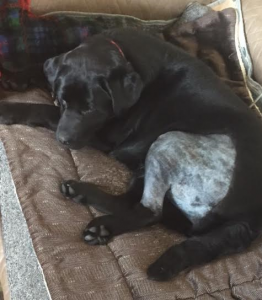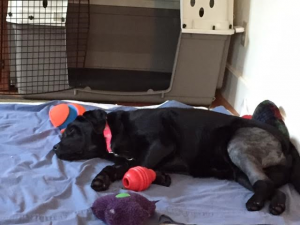As Rose begins her third week of recovery, she continues to improve. She saw her veterinarian and he was pleased with her recovery. She may now walk five minutes/day on leash (slow walk). She still must potty on leash to prevent her from running or jumping. This was her first walk. Please forgive me holding the camera the wrong way!
Category: Care
Rose’s TPLO Recovery Week 2
As we begin the second week (of six where she is not permitted to walk except to potty) we do all we can to keep her entertained. She managed to chew her inflatable collar and puncture it., but we believe her wound is healed enough now to tolerate the small amount of licking she does. She is beginning to grow coat on her leg, and the growing fur must itch. When we take her out to potty, she puts some weight on her foot, but not so much as to worry us. The veterinarian stated that it was fine to put weight on the foot as she will tolerate it, but she is still on restriction. She is not permitted to go on a walk or play with other dogs. She is still on “bedrest”.
We take her on car rides with us, so that her scenery changes, and so that she always has company with her. She enjoys her rides, and is usually exhausted once we come home:


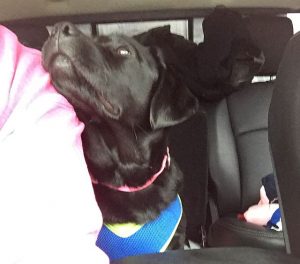
Today (4/3/17) we had a nice sunny day (the snow has just melted), so I took her outside to just sit in the sun and suck up a bit of warm sunshine. She enjoyed it a great deal.
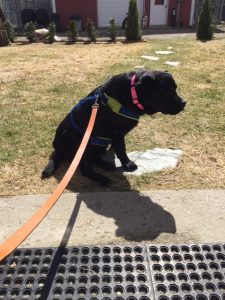
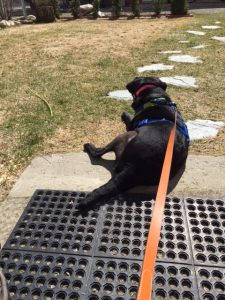
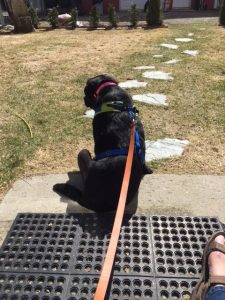
Rose’s TPLO Recovery Day 7
Rose’s sutures are evidently starting to itch, and she is licking her knee. That has earned her the “cone of shame” for awhile, to keep her off of the sutures, until she’s at the 10-14 day mark, when the wound is likely healed.
She continues to be obviously bored, and at times rocks back and forth on her back. We know she’s tired of being in the same place, not allowed to walk about or play. This is very hard for a 8 month old puppy. It’s not natural for them to stay put for weeks on end. Yet, she is on strict orders by her surgeon to have strict “crate rest”, and not be allowed to go out for any reason other than to go potty, and that must be on leash. We’re trying to find ways to resolve her boredom. I bring her up on the couch with me to snuggle, but she tires easily of that too. Nothing holds her attention for very long.
Boredom:
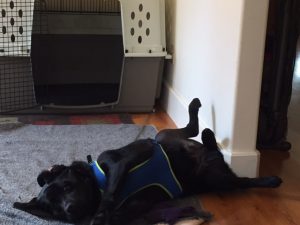
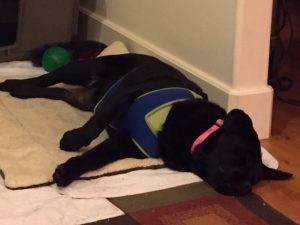

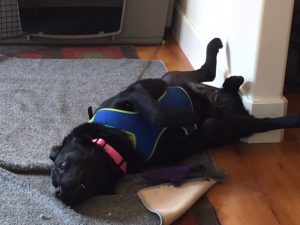

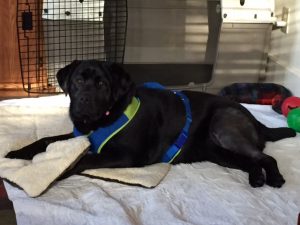
Rose’s TPLO Recovery Day 4
Monday 3/27/17 – Tues. 3/28/17
We are Icing Rose’s knee a few times each day, as she has quite a bit of swelling distal to the knee. It’s hard to elevate the leg of a young dog. Pillows make for good eating! So, we are just making sure to keep it cool to reduce swelling.

Rose seems to be in less pain, and because she has not had a B.M. since her surgery, we’re giving her pain medication less often. She’s still on a anti-inflammatory, so that helps with pain, but narcotic medications increases constipation, and we don’t want that! Pain is a natural part of healing, and as long as she is not distressed (crying or agitated), pain keeps her off that leg and quiet.

But, Rose is starting to show signs of boredom. Since she was on crate rest for almost three weeks before her surgery, it makes sense that this poor 7 month old is going out of her mind with boredom. If she is not in her crate, she has to be tethered, to prevent jumping or walking around on that knee. But she’s starting to look a bit pitiful.

Yesterday we decided to buy her some interactive toys, and take her with us in the truck. When the back seat lays down, it provides a perfect flat surface for her to travel on, and maybe seeing something other than our den will help liven her up:
Rose, want to go for a ride?
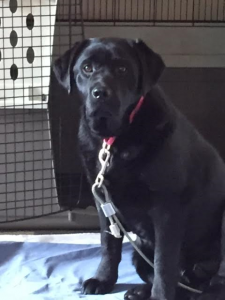
She looked at everything along the ride!
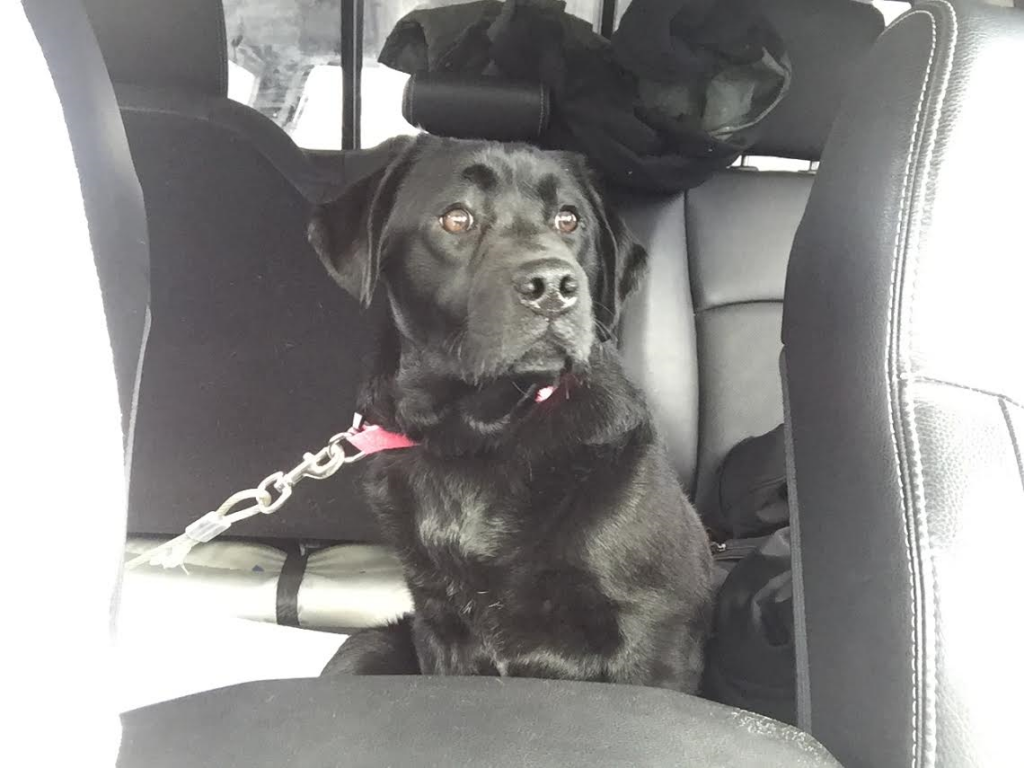

She came home exhausted, and slept for hours. Oh, and when we came home, and she had her first B.M. since surgery. Yay!
We bought a few interactive toys for her, and they should help entertain her a bit more. She’s enjoying them today.(Tues 3/28/17)
Rose’s TPLO Recovery day2
3/26/17
We won’t be updating every day, but for the first day or two, there is a lot to cover with respect to care of a dog with a fresh TPLO surgery.
Rose’s mood has greatly improved. We had her on a baby monitor all night and did not hear a peep from her. No more crying this morning either. She’s hooked to our baseboard (eyebolt and tether) so that she can not get any further from her crate than she is now, and can’t attempt to roam, jump or otherwise use her leg. Her incision looks great. She has quite a bit of distal swelling, but almost no bruising for now. It’s hard to keep an ice pack on it, as she wants to chew it, and if I sit with her, she wants to play, so I give her a treat puzzle to keep her busy while the ice is on. The ice pack still wants to slip off her knee (we had it covered with a pillowcase so as not to be directly on her skin).
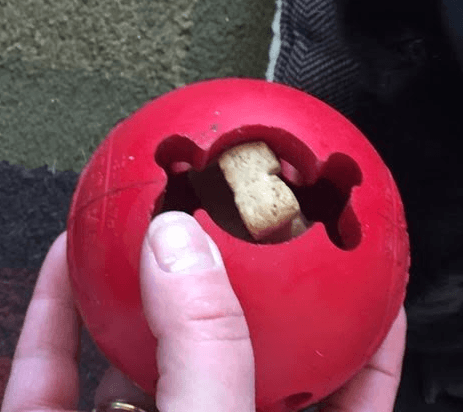

While folks have been using a bag of peas for ice packs for a long time, I came upon a better idea years ago, that you may wish to try;
While we were trying to provide her with a nice-thick place to lie down, she became very distressed on the overstuffed bed. When we put her in her crate last night she settled down completely. All her crate has in it is a horse stall pad, which is a thick rubber pad. We assumed she might vomit during the night, or have a bowel movement or urine, as she was sedated and was medicated for pain, but we found she settled down greatly when put on that hard rubber surface. It would seem that the overstuffing was causing pressure and pain. We’ve removed that, and just laid down some flat bedding for her. She has been in the crate so long and is so good about staying put when on the floor (she’s tethered to the wall with a leash to prevent her from walking about), that when we’re in the room, we let her lie there.
Thick bed vs thin bedding … thin equals more comfort for her. She can finally relax:
Her wound looks amazing, and I found a better way to ice her knee. I use 4″ colban wrap (LOOSLY) around the pack, which holds the ice pack on, and she’s tolerating that well. She has some distal (below the knee) swelling in her hock that I want to reduce, and five she was only able to tolerate a few minutes of icing otherwise. She thought I was there to play with her, and wiggled around so much, that the ice pack would not stay on. Problem solved. Remember, always put something between an ice pack and the skin, as you do not want to add frostbite to your list of problems!
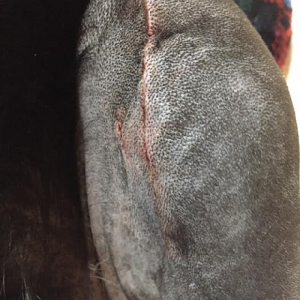

The wound looks amazing, and we solved the problem with the ice pack that wouldn’t stay on her knee.
She’s getting the idea of assisted walking:
Rose TPLO recovery day1
3/25/17:
We were at the office to pick up Rose at 8:15am. She’d had a hard night, which is to be expected. She had vomited, had some diarrhea, and cried much of the night. They had treated her pain, and sedated her, but she was still quite uncomfortable. We left with our girl, and the following meds: Pain med, sedative, antibiotic, and anti-inflammatory. She is now to be only walked to go potty, navigate no stairs, no jumping or playing. She is to be kept off her leg for the next six weeks. Right now, she will be supported while walking, to protect both her surgical knee and her other knee (reduce the stress and strain on the good knee, which often incurs so much injury from acting as the only good leg, that it too ruptures). One can use a towel as a sling, but we have found a horse cinch to be useful in the past for old dogs who can’t get up, that we bought a new one (we wanted no bacteria near her surgical site by using an old one).
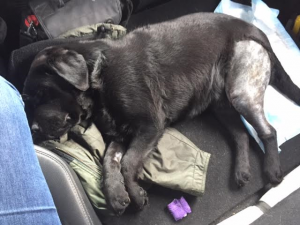
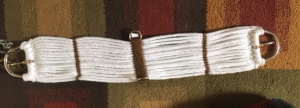
But for now, we’ll carry her. She’s confused and in pain:
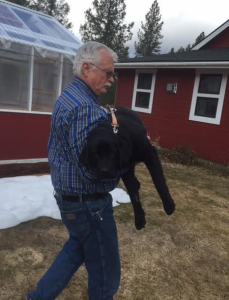
How much pain? This should demonstrate that well. This was our drive home. Even with pain meds and sedatives, she was just plain miserable! Her pain broke our hearts.
We prepared for a rough night, but after getting home and in a crate she recognized, and with the sounds of home, she settled down.
Rose’s CCL Injury Part2
Rose’s knee showed great improvement on the anti-inflammatories. Her limp decreased greatly. The swelling in her knee went way down. We weren’t fooling ourselves, she was on an anti-inflammatory, and since it may have been be a partial tear of the CCL, rather than a full tear, but we knew a partial tear of the CCL can go complete in the bat of an eye, but at least we had improvement, which gave us hope that she had only sprained her knee.
Her follow-up Vet. exam dashed hopes of a sprain. With a considerable amount of swelling down, he now could feel significant drawer sign. He confirmed great suspicion of a CCL tear. We decided that rather than have our regular vet do the fix, that we’d go to a surgical specialist in Spokane, WA, to which he was in full agreement.
Her appointment with the Specialist was just shy of a week later. Rose had been on strict crate rest for over 2 weeks. That’s pretty hard on a 7 month old puppy. The Orthopedist examined Rose, and scratching his head, stated that there was a little drawer sign, but not much more than on her good knee (normal “puppy drawer”). She has a grade 2-ish limp. No pain on exam, the patella is rock solid, and he gets no “pop” from the meniscus. Not completely sure, we agreed to more x-rays to see what it looks like now that the swelling is down.

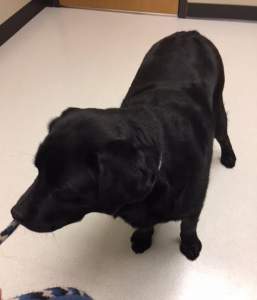
Rose, patiently waiting for her exam at the surgical specialist’s office.
At worst, it would be a early CCL partial tear. At best, a grade 3 sprain. While we waited for x-ray results, we weighed our options for repair should it be a partial. We know darned well, it will become a full eventually if it is, but the question is conservative vs dynamic repair (anterior suture vs TPLO). Exploratory surgery for diagnostics was not an option as it just introduces other potentials in the joint that nobody wants, related to unnecessarily risk.
She was sedated for her x-ray, and x-rays of both of her knees (for comparison) were taken. While she was sedated he manipulated her knee again, and now that she could not resist, he could clearly feel drawer sign. She had a tear. We suspected it was partial, but partial is like a frayed rubber band, just ready to go. Full rupture would be inevitable, or she would develop a great deal of scar tissue to protect the joint. With her being only 7 months old, we believed the only option was full dynamic repair (a TPLO – TIBIAL PLATEU LEVELING OSTIOTOMY)
We signed the consents and left our baby in their care, to have surgery that day. The cost including the x-rays that day would be just short of $3,500. We went home to await word. We knew she would be staying at the office until the next morning.
Rose’s CCL Injury part1
We finally had a nice day after a hard winter. We had four feet of snow on the ground, and a lot of ice. My three young dogs were getting cabin fever, and we thought we’d let them run a bit on our first sunny day. It would prove to be a fateful decision for our 7 1/2 month old puppy, Rose. Poor little Rose hurt her knee playing with her sister, Dahlia, and older kennel-mate, Luna. The three puppies shot from the kennel with a purpose. In a full run, body slamming, slipping and sliding. Rose got caught in a frenzy of Labrador energy, and paid the price. She came up on three legs. We knew immediately we were looking at a cranial cruciate ligament injury. Immediately, plans for a wonderful show career for this girl evaporated. We crated her, and called the vet.
Rose: Note the swelling in her left knee:
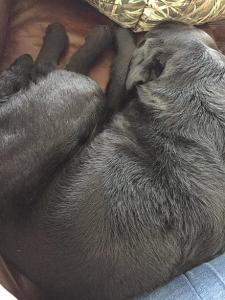
Our poor baby! It breaks my heart to see her hurting.

She saw the vet a few days later. Her diagnosis at the vet was inconclusive, where she is swollen and lame, x-ray and manipulation diagnostic for ligament injury didn’t reveal anything positive, and there is no fracture, so, the vet wants strict joint rest for the next 10 days. He could not feel “drawer sign” in the knee, but the knee was quite swollen, and likely the swelling itself was splinting the knee from providing him with exam clues. X-ray showed a great deal of effusion (swelling). Rose will be living in a crate for the duration – rather like strict bedrest. Since I’m sitting in the den, I lifted her into the couch with me (no jumping up or down allowed), as a seven month old needs physical contact, especially Rose, who is a lovebug! He put her on an anti-inflammatory, and suggested we keep her on that for 10 days, then re-eval the knee. In the meantime, she would be on strict crate rest.
We went home, suspecting that we were looking at knee surgery for our girl, and had decisions to make with respect to the type of surgery we wished to do.
Click here for a Description of CCL injury and treatment
This is Rose on day two of her CCL Injury treatment with anti-inflammatories and crate rest only. She is trying to use the leg, but clearly it is swollen and painful.
Fading Puppy, or Failure To Thrive Syndrome
Written on April 20, 2004 – transposed to newly designed website – 2017
Typically, failure to thrive, or “fading puppies” appear vigorous and healthy at birth and suckle with no difficulty. Within a day or two, become progressively weaker, make less vigorous attempts at nursing, lose weight rapidly, and die. Fading puppies should not be confused with a litter suffering from Canine Herpes Virus.
There are often positions or movements (or lack of movements) that these puppies display. A normal puppy twitches and moves frequently. The first signs of a fading puppy are often that they lie still, with less of the jerking and moving that their littermates do. They often lie on their stomachs, with their heads stretched out. Even though pneumonia is often difficult to diagnose in a puppy this young, if a puppy is positioning itself in a sniffing position, it should be suspected, and often the vet will treat for pneumonia at this time, even if a positive diagnosis can’t be made. Cardiac problems with resulting hypoxia can also be a cause of this. Their heads may sway from side to side, and where they vigorously nursed on the first day, each day they seem to have less and less energy as the days go by, and despite adequate milk, do not thrive and grow poorly. They frequently begin to look unthrifty. Their body tone lacks the firmness of their littermates, their coats are coarse, and often a breeder reflects that that they “just didn’t look right”. They often have what I refer to as a “mewing” cry before death. It is absolutely a cry of distress, and causes both breeder and the bitch to experience a great deal of distress as well. It has a high tone, anxious quality to it. This cry is very difficult to listen to for both breeder and the bitch. In the end, fading puppies lack the body fat that their littermates are rapidly developing, despite extra bottle feeding, which often by this time, the breeder has begun. They often suffer from a variety of digestive upsets and respiratory problems. They usually die within 5 – 10 days.
The term, “fading puppy syndrome”, describes symptoms, rather than an actual disease. Fading puppy syndrome is thought to be caused by bacterial or viral infection, inborn metabolic problems, or physical causes (such as renal or cardiac anomalies).
Before you consider that a puppy is suffering from fading puppy syndrome, be aware of a few specific issues. Look first to hypothermia being the cause of any puppy having trouble. Hypothermia is the number one cause of death in the neonatal puppy. Second, be sure the puppy is not dehydrated. Puppies have no physical reserves, and dehydrate quickly. Treat for hypoglycemia *only after warming the puppy to normal body temperature*. Giving glucose will show positive results in moments if hypoglycemia is the issue.
Bacterial Infection can start in the navel stump. Although, it can be transmitted in the uterus prior to birth or in the vaginal canal during birth, and contaminates the pups causing general sepsis. In severe cases, puppies that are born small and weak may already be infected by the germs that build up in the womb, because of a low-grade infection in the uterine horn(s), and infection quickly spreads. Veterinary treatment is a must. A full course of antibiotics may treat an infection, or delay the onset of secondary bacterial infection, however, one should never give antibiotics blindly. Overuse of antibiotics “just in case”has led to methicillin resistant bacteria directly caused by the overuse of antibiotics in todays society.
Viral infection tends to occur later than the first week of life.
Physical anomalies are often the cause of fading puppy syndrome, and are often not discovered unless a necropsy is done.
A newer therapy, is to give oral blood serum to puppies for the first 72 hours of life, or a IV injection of blood serum from a healthy dog. Collection of the blood and preparation of the serum should be left to your vet.
Extra warmth, bottle feeding, and antibiotics (if the vet prescribed them) will help to increase the chance of recovery. It is essential that a fading puppy be kept warm and receive extra calories if there is to be a chance of recovery. But be aware, that with even the most vigorous treatment, often puppies just don’t make it. One of the hardest things for a breeder to do, is to simply understand that nature must take its course, and sometimes, fighting too hard to save a puppy can bring heartache later, when physical anomalies are discovered, and there is little to no hope of saving a puppy after endless hours of attempts to save it.
The following photographs shows the poor development of a fading puppy. In this puppy, it was noted on day two, that she often held her head in a “sniffing position”. Pneumonia was suspected, and antibiotics begun. On day three, she had lost body tone, and although she was nursing well, and eagerly, she did not have the body fat her littermates did. She moved less than they did. Bottle feeding began on day three. She eagerly nursed from the bottle, and took good quantities of milk, only to return to the box and nurse from her mother, although still, she gained no weight. Finally, on day five, she appeared weaker, and nursed less enthusiastically. Her bottle feedings increased, and although she suckled the milk, she tended to chew the nipple more. When given to her mother for some motherly attention, she tended to crawl under her mother, or behind her. I have noticed before, that poor doers often root under their mother, and on the last day, crawl away from her and into a cold area of the box, where they die. No infection was found in her blood culture. Her veterinarian treated her with an antibiotic because her lungs sounded ever-so-slightly off (hard to appreciate in a neonate), although her lungs looked clear on x-ray. At that point, despite all the added feedings, antibiotics, warming, and all the TLC we could provide, she was about 1/3 the weight of her littermates, having gained almost no weight since birth. On day six she died.
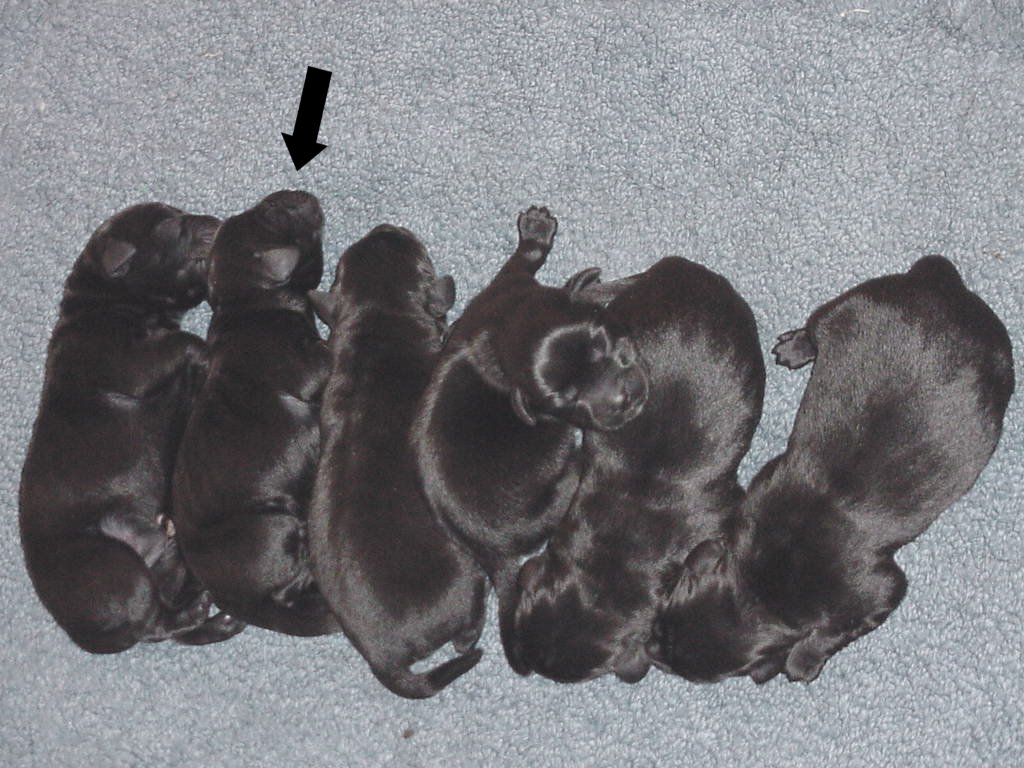
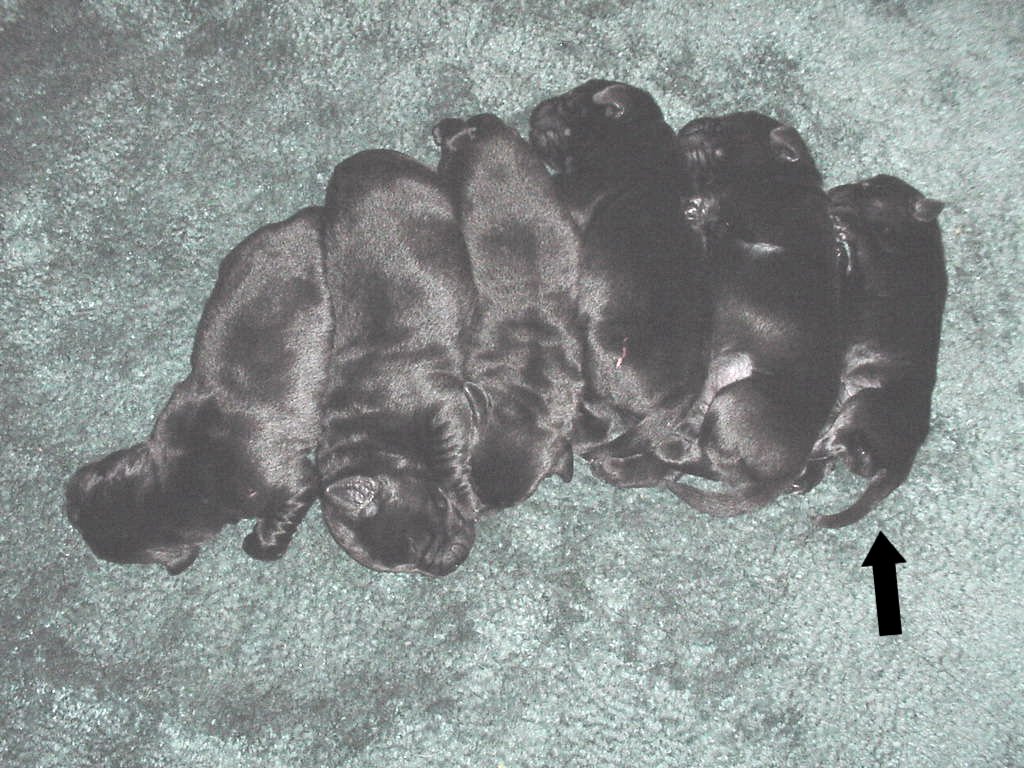
These neonatal deaths are always very difficult for a breeder, but each of us should realize that nature often knows best, and despite our attempts at beating nature, she often wins the day. In the end, I had started fluids on the puppy, given her plasma, had her on a heating pad of her own, and tried everything there was to do until she took her last breath. I am left with the knowledge that I did all that I could. That’s all we can do.
Legal stuff:
Website Built by Blue Knight. All graphics , photographs, and original articles are the property of Blue Knight. Permission must be obtained for use on other sites or for other purposes
AKC Inspections
 “In compliance” is all about paperwork, care, and identification!
“In compliance” is all about paperwork, care, and identification!
*ALL* breeders of AKC puppies are held to a standard of practice by the AKC. The standard of practice is called the AKC rules of compliance. The rules of compliance set the standard for regarding record keeping, identification and maintaining proper care of the dogs and kennel conditions.
Passing an AKC inspection is *not* something any breeder should feel the need to brag about. It is expected that all breeders *should* pass inspection. This article is intended to prevent you from being fooled by those who would suggest that their “in compliance” status is unique or special.
Who Gets Inspected?
- Any AKC customer (breeder, retail pet shop or broker) that registers 4 or more litters per year or conducts 25 or more registration transactions per year (supplemental transfer statements) is automatically added to the list for inspection.
- Breeders who register 4 to 6 litters annually with AKC will be randomly selected for inspection.
- Inspections will also be performed in response to complaints, which can stem from concerns over unhealthy facilities to unfounded harassment by a vengeful competitor or disgruntled co-owner. While complaints must be submitted to the AKC in writing and be signed, an inspector will follow up on every one and will not reveal the complainant’s identify unless requested by a court order.
We at Blue Knight have been inspected, and found to be in compliance, however, this does not mean puppies from us or any other “in compliance” kennel is superior to others. It simply means we were in compliance with the record keeping rules that he AKC sets down for all breeders. If we were not, we would have had our AKC privileges suspended and we would have been fined! A $250.00 fee is required prior to re-inspection. Customers who fail to correct deficiencies and maintain compliance are subject to discipline ranging from letters of reprimand to 10-year suspensions coupled with $2,000 fines.
Investigators also work with local authorities to assure proper care of dogs. Fines and suspensions are published monthly in the AKC Gazette and on the AKC Web site in the Board minutes. The AKC completes some 5,000 kennel inspections each year (2004 and 2005 stats).
I have seen some breeders boasting their “in compliance” status. Don’t be fooled into thinking this is anything more than it is — it is no more special than your local restaurant passing a health inspection. To do what they do, they must pass inspection. That is the minimum you would require of them. Being in compliance with the AKC is the minimum standard by which a breeder should maintain their dogs.
We found the AKC Inspector to be professional and thorough. This is the job of the AKC Inspector. Should we have greater than three litters in a calendar year, we expect to see her again. This is just an expected part of breeding AKC registered dogs!
AKC Rules of Compliance
Investigations and Inspections
The AKC is the only purebred registry in the United States with an ongoing routine kennel inspection program. The AKC has a dedicated team of field inspectors who visit kennels to help breeders while ensuring the proper care and conditions of AKC-registered dogs and verify that breeders are maintaining accurate records for their dogs. Since 2000, AKC field inspectors have conducted over 45,000 inspections nationwide.Routine AKC field inspections involve several steps. Field agents begin every visit with a tour of the overall facility checking that the dogs as well as the condition of their environment are in good order. Field agents also check the dogs for proper identification, microchip, tattoo or collar tag.
After a thorough look at the dogs the field agent will review the breeder’s records, often advising the breeder with options on how to maintain hard copies in addition to using the convenient AKC online record system. Breeders are expected to maintain records for at least five years.
AKC randomly selects breeders for inspection yearly. In addition, to the random selection AKC inspects breeders based on written, signed and substantiated complaints.Through kennel visits, inspectors seek to work with breeders to help correct any deficiencies, as well as help new breeders develop effective practices and procedures.
If an inspector finds minor deficiencies, the issues are noted and discussed with the breeder in an effort to help the breeder while at the same time meeting AKC’s requirements in the future. While the AKC does not have penal or regulatory authority, breeders who have major kennel deficiencies may lose AKC privileges (ability to register dogs or compete in events). In some cases, fines will be imposed, AKC privileges may be suspended and appropriate law enforcement authorities contacted.
The standard penalty for anyone convicted of animal cruelty involving dogs is a 10-year suspension and a $2,000 fine.
Contact the Compliance dept: AKC Investigations and Inspections, 8051 Arco Corporate Drive, Suite 100. Raleigh, NC 27617-3390. Phone: (919) 816-3629, Fax: (919) 816-4246
